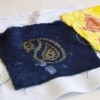
by Julie Wertz and Jing Han, PhD students.
This year the Centre for Textile Conservation and Technical Art History collaborated with the School of Chemistry to host a hands-on workshop for students aged 12-14. Two sessions of about 90 minutes each took place as part of the Glasgow Science Festival. The event was funded by the University of Glasgow’s New Initiatives Fund and aimed to expose the students to Scottish textile heritage and how chemistry is present in our everyday lives. The participants, around 60 in total, were given an introduction to textiles and textile history before splitting up into small groups for some practical sessions.
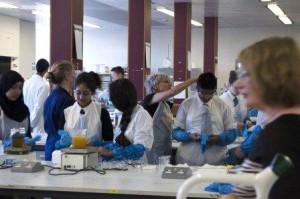
‘It was really fun and I thought it would be boring’.
Interesting effect of minerals on madder. After the introduction, a demonstration of the effect of different mordants (substances that combine with a dye or stain to fix it in a material) on madder dye was begun. Madder roots contain huge amounts of red colourants and were used by humans as long as 5000 years ago for dyeing red. In the workshop we demonstrated madder dyeing pretreated with different minerals to achieve various colour shades and improve the fastness of dyed fabrics at the same time.
Self-directed dyeing. Within their small groups, each student got to dye a piece of wool with indigo, a piece of wool with turmeric, and a piece of cotton with turmeric. Turmeric, the spice that makes curry yellow, works as a textile dye but has poor light and wash fastness properties. The participants dyed a piece of cotton and a piece of wool golden yellow with turmeric. The students also dyed wool with indigo. Indigo is the colourant for jeans and is very special because it undergoes the dyeing process via reduction and oxidisation. Most dyes require the use of a mordant, as demonstrated with the madder baths, but indigo does not. Pieces of wool fabric were soaked into greenish yellow solution of reduced indigo for a while, and then removed and exposed to air. As the indigo oxidized, the colour changed gradually to blue. Magic?
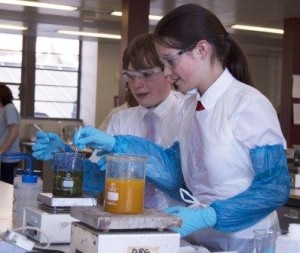
‘It is good to create art and chemistry together.’
Print your own Scottish Pattern. After drying the samples, the students took their dyed fabric to the block printing bench, where they used linoleum blocks carved with designs taken from Turkey red prints in the University of Glasgow Archives. They experimented with printing paint on paper and applying textile ink to fabric. Chemistry was present again when the students applied colourless textile ink with an alkali pH to the turmeric-dyed cotton as when when printed with a base, the golden-yellow changes to red! Adding a few drops of acid changes the colour back to yellow again. Typical Scottish patterns including the droplet-shaped floral Persian motif, abstract geometric plants, figurative birds, butterflies, both positive and negative images, were carved for block printing. Inks of golden, silver and other various colours were used.
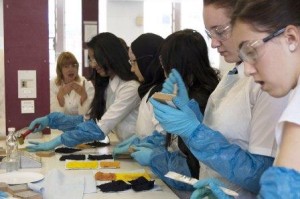
For the students, the whole workshop was full of fun because they not only got hands-on experiences of dyeing and printing in traditional Scottish handicrafts, but they also got a flavour of the magical power of chemistry involved. With dye baths of various colours and printing blocks of different patterns, pieces of wool and cotton were changed into exciting artwork. 19th century Scottish dyeing and printing handicraft came to life again in the lab. The chemistry involved was a big surprise for them as well. As one young person said, ‘I didn’t think science and art can (be) combined’. This is exactly the message we were hoping to share.
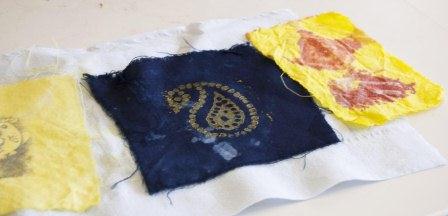
“The patterns were so cool!’
Want to learn more? Dye History from 2600 BC to the 20th Century by Susan C. Druding http://www.straw.com/sig/dyehist.htmlhttp://www.chemistryexplained.com/Di-Fa/Dyes.html#ixzz335ryArXF Want to try this at home? www.georgeweil.com (search for kits) www.artstore.co.uk (block printing)

